The Colnago C64 Is Cycling’s Modern Heirloom
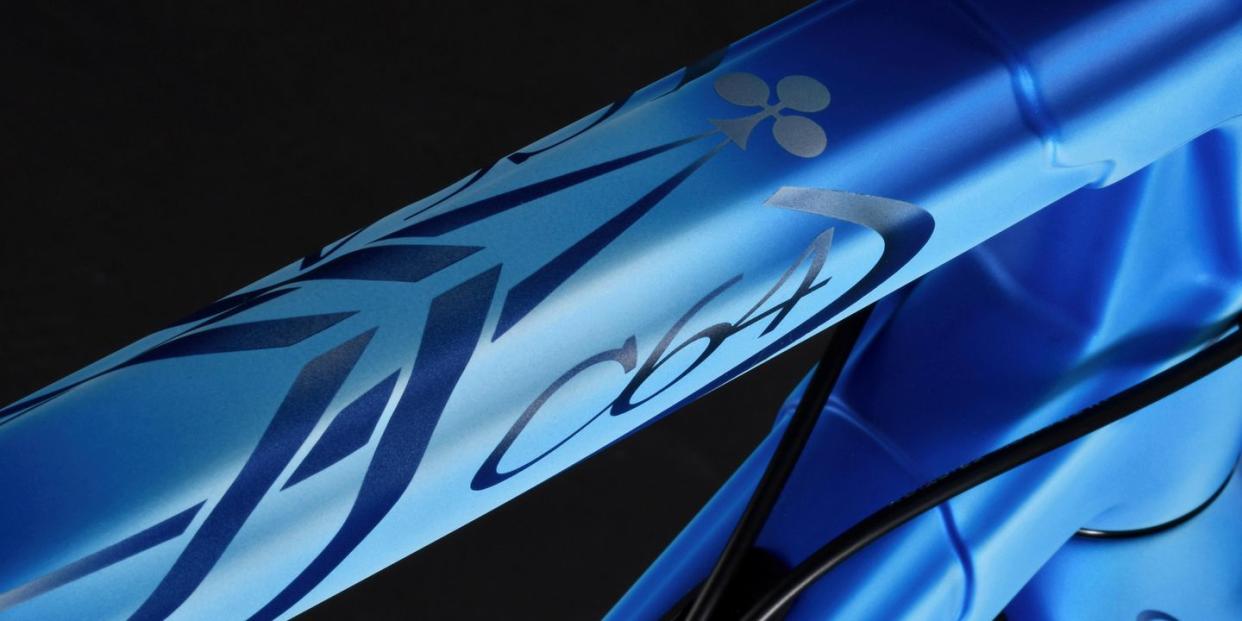
One of the astounding marvels of the bicycle is that from the very beginning we got it right-140 years after the first appearance of the pedal-and-chain-driven two-wheeler, its form and how it functions remain essentially unchanged. And rather than make bikes feel old-fashioned or turn them into anachronisms, this unbroken connection to the past is a rich legacy that colors, informs, and influences us. Ernesto Colnago is our last living direct link to our deep history. His masterful C64 is the product of it.
Stay with this.
For people born too late, Fausto Coppi is a myth. Yes. It is as if he never existed. Or. You see pictures of him; alone in the mountains. Together with fans. On the podium. But you don’t necessarily combine those pictures into a real human being. It is as if the person has been constructed to create the idea of Fausto Coppi, that is, the idea of the greatest cyclist of all time. Yes. Eddy Merckx is the strongest and most successful cyclist that ever lived and his achievements will never be matched. We know that. Fausto Coppi, however, is the greatest of all time. This has nothing to do with results but how victories came about. And his style. His attitude. Important criteria for the fans that follow the world of professional cycling. How he takes his bidon from a bottle cage and how he places it again after a drink. Very important.
Fausto Coppi isn’t real like Eddy Merckx is real. The living legend from Belgium looks like the man we know from photos. These days he is twice as big and more wrinkled. In other words: Eddy Merckx looks like an older version of Eddy Merckx. But he is definitely a real person. You see him at races. He is drinking coffee or he will remove his jacket before getting into a car. He is doing normal things. And when you see him together with, say, Vincenzo Nibali or Chris Froome, the past and the present combine into a joint history. These guys are winning what this guy was winning before them. And it ensures us that these races were also raced before we can remember.
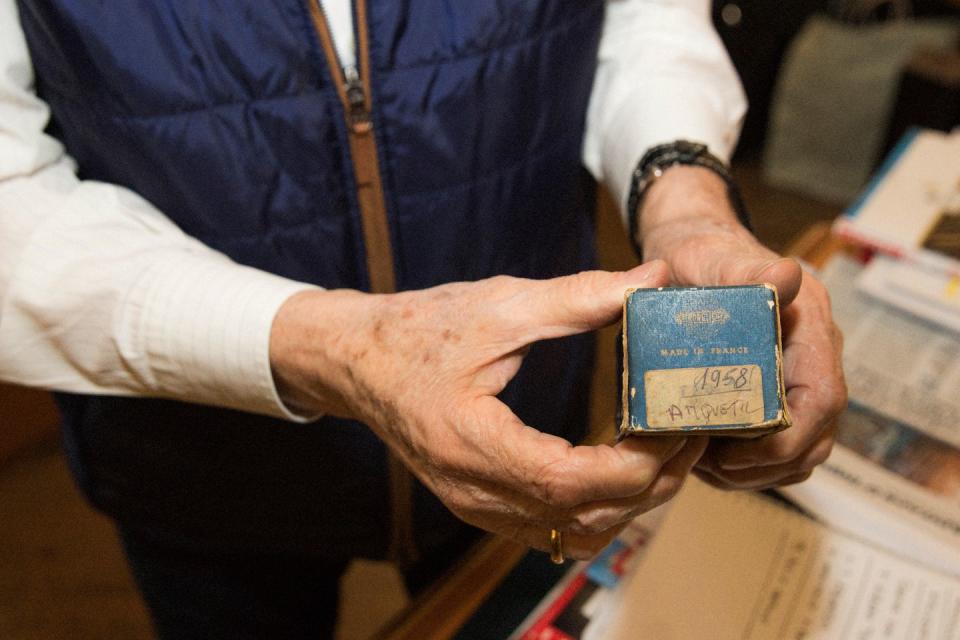
Old pictures of Fausto Coppi look like old pictures of Fausto Coppi. He is two-dimensional. Black and white or those awful hand-colored photographs. Sometimes he is carved out of wood. Or made of bronze. Oftentimes he is hanging in a bar in Italy, some old framework, right in the back or overlooking the room next to the toilet or a slot machine. Like a guardian angel. A small religious elf.
Fausto Coppi is Peter Pan. Someone made him up! That’s right! If you don’t believe in him, he doesn’t exist! You have to continue to believe in Fausto Coppi, which only makes it more difficult for us to accept or understand the myth of the greatest cyclist of all time. So when you meet a gentleman who has actually met Fausto Coppi, how are you supposed to react?
It is like this: Wait, what, he existed, you are saying, he existed like an actual person, now I’m a child, tell me something about him that makes it understandable, did he once comb his dark blue hair back, give me some human explanation, I want someone to tell me that, yes, it is true, I was with Fausto Coppi, and he put his sunglasses on because the sun came out.
Wow.
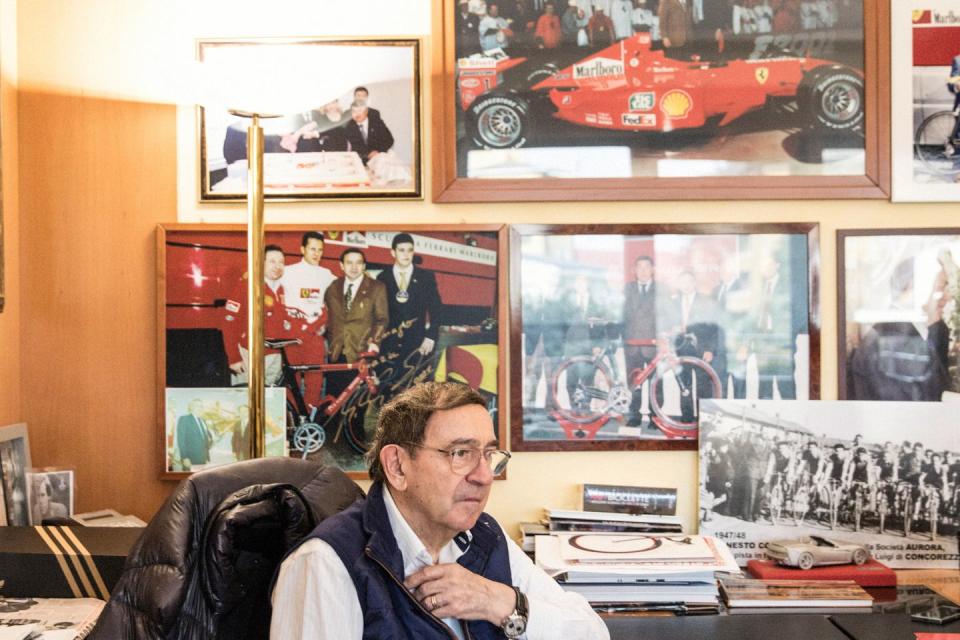
The elderly gentleman sitting across the table is Ernesto Colnago. Now he moves forward. “So Fausto Coppi. This was Il Giro in 1956. I was the mechanic for Magni, of course, who was also my friend. I was there in service of him. But I was a fan of Coppi. One day Fausto had problems with his bike. And I helped him. And Coppi paid me 1,000 lire. I kept that money in my pocket for 20 years.”
Wow.
Today Mr. Ernesto Colnago is 87 years old and a living legend. He’s been in the world of professional cycling for longer than anyone else alive, he has seen it all and done more of the same, and his Colnago bikes and especially its logo is arguably our sport’s most famous and treasured trademark. He says: “You think of a bicycle and you think Colnago. I became Colnago because I think outside the box. Always. I was the first to create custom-built frames.”
Somewhere a church bell goes off.
We’ve been riding Colnago for more than six decades, the company’s 60th anniversary was in 2014, and so therefore he carries our history with him as we-and the professional cyclists-carry his. As a mechanic, and later, team sponsor, he has worked 25 Tours de France and 25 Giros plus every other race in the calendar. In other words: If it has happened, chances are good that he was there when it happened. The Colnago brand has won 62 World Championships. 38 Classics. 21 Grand Tours. And medaled at 18 Olympic Games.
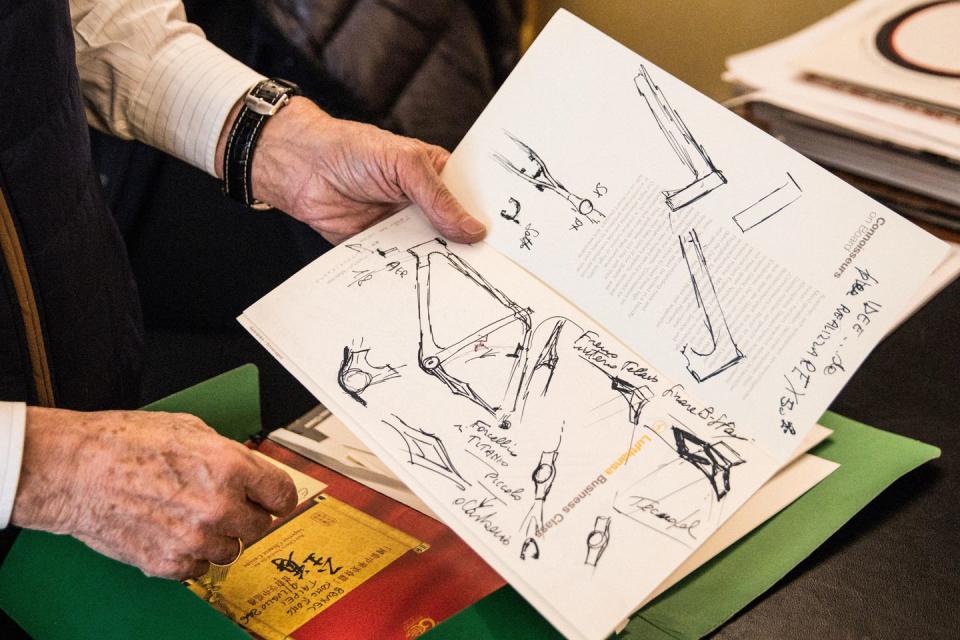
And so there he sits, in his enormous office, looking exactly like Ernesto Colnago. Like with all famous people, smaller than you’d think. But he oozes charisma. The kind of charisma you can’t learn or buy or steal. For decades people have understood how to keep quiet and listen when he talks, so this is what he brings to a room. The feeling of serious. His mere presence suggests that something is about to unseat us, because nobody lets a man of his stature into the ring for no reason.
Ernesto Colnago is sometimes referred to as Maestro. Or Capo. Meaning The Boss. But this is utter nonsense. Colnago works for us. He is put here in service of cycling. And we to get to witness it. You look at his newest model in a magazine. Maybe you get to touch one in a bike shop. Perhaps you even get to buy one, or if you are lucky, you get to see and meet him. And then it gets complicated. Because you want to take in as much as you can, you want to prolong the moment, you want to stay in his presence, be in his life somehow and let it rub off onto you, because there is something absolutely compelling about greatness. Yes. When you witness greatness, or are in the vicinity of greatness, it gives you a different perspective on the world. It alters it. It is inspiring that Ernesto Colnago has shown us that he has what it takes. It is simply comforting for a man to know that if he doesn’t have what it takes, then at least someone else has it for him.
Three more bike industry obsessives
Mike Sinyard, Specialized • The founder and CEO of Specialized is sometimes called the bike industry’s Steve Jobs. Such comparisons can be dangerously facile, but in Sinyard’s case, it fits: Like Jobs, Sinyard demands constant innovation; bike lines are constantly refreshed. Like Jobs, he has a clear, inerrant sense of what a Specialized product should look and feel like. And like Jobs, he doesn’t directly design or create Specialized’s products, but he’s the driving force that made Specialized into one of the biggest bike companies in the world. Would Steve Jobs have built a wind tunnel if he thought it would make better iPhones? Of course. Mike Sinyard doesn’t make bikes, or wheels, or helmets. But nothing Specialized does would be possible without him.
Wayne Stetina, Shimano • If you’ve ever had a road or mountain bike with Shimano parts, you’ve felt Wayne Stetina’s influence. How could a mere vice president of the American bicycle division of a large, multinational company have such an outsize impact? Simple force of obsession. Thanks to Stetina’s relentless focus on component weight, in the 1990s, Shimano put gram scales on the desk of every engineer in its Osaka, Japan, headquarters. Thanks in part to Stetina, XTR came to be through the efforts of the company’s well-known “Skunk Works” design crew like Joe Murray and Paul Thomasberg. Wayne’s obsession expressed itself not only in seven national road titles and berths in the 1972 and 1976 Olympics, but also in pretty much every significant component innovation at Shimano for the last three decades.
Josh Poertner, Silca • Imagine the hubris of some random dude from the Midwest thinking he’s the one who can resurrect a storied Italian accessory brand, and then making its first product a $450 floor pump? But Josh Poertner did just that with Silca. Poertner, a former technical director from Zipp, set out to recast Silca’s romanticized past with a new reputation for next-level engineering and quality. How else to explain a braided hose rated to 12,000 psi, or NASA-level machining tolerances, or that utterly pointless (but gorgeous) lathe-turned rosewood handle? The Super Pista Ultimate was crazy, but it worked, and set the die for every Silca product to follow. -Joe Lindsey
From his office at the Colnago factory, you can see Mr. Colnago’s private estate. It’s a huge mansion, just across the street. On the gated entrance is his logo, the Colnago logo. The logo came about when a journalist from La Gazzetta dello Sport, Bruno Raschi, one evening took out an ace of clubs from a pack of cards and told Colnago to record the clover as a trademark. We know the story. In fact, there isn’t much left to tell about a man like Ernesto Colnago. His life in cycling has been well documented, in his office there are memorabilia to fill a medium-sized museum, and in the corridors and hallways are photos to prove the rich and colorful life of cycling for the past seven or eight decades.
“Mr. Colnago. Have you become the man you as a young man thought you could become?”
“In 1984 I visited Enzo Ferrari. I was so nervous it is difficult to explain. And so there he was. He was an old man, 87 years old at the time. Like me today. I am his age today. Ferrari was wearing dark sunglasses in his dark office. I sat down. He asked me how old I was, and I responded that I was already an old man, 54 years at the time. Enzo Ferrari was quiet. Then he said, ‘Shame on you. I began making great cars at 54!’”
“Ha! That’s a great answer!”
He leans forward, continuing a story I didn’t know he’d started.
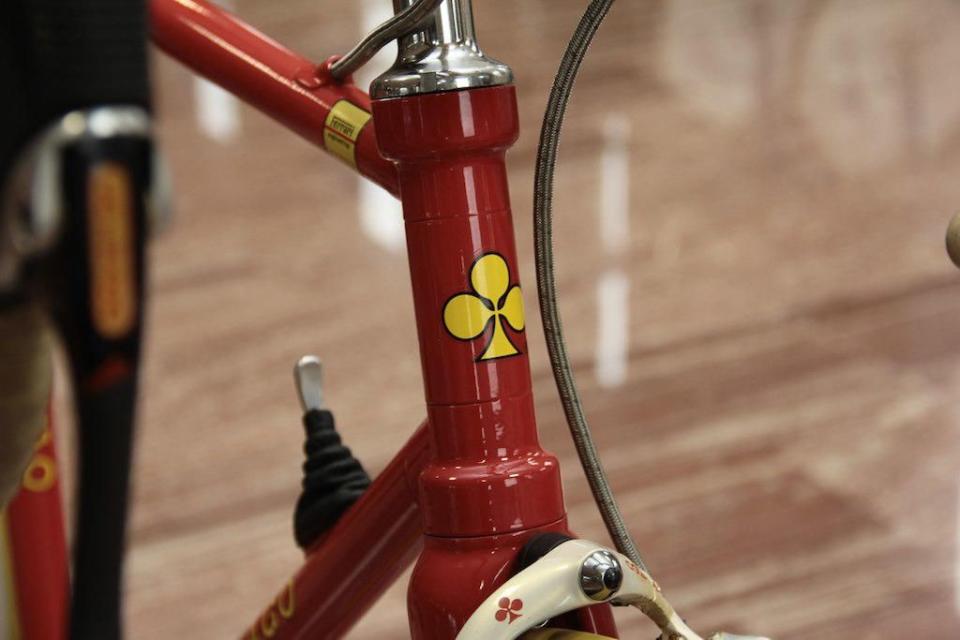
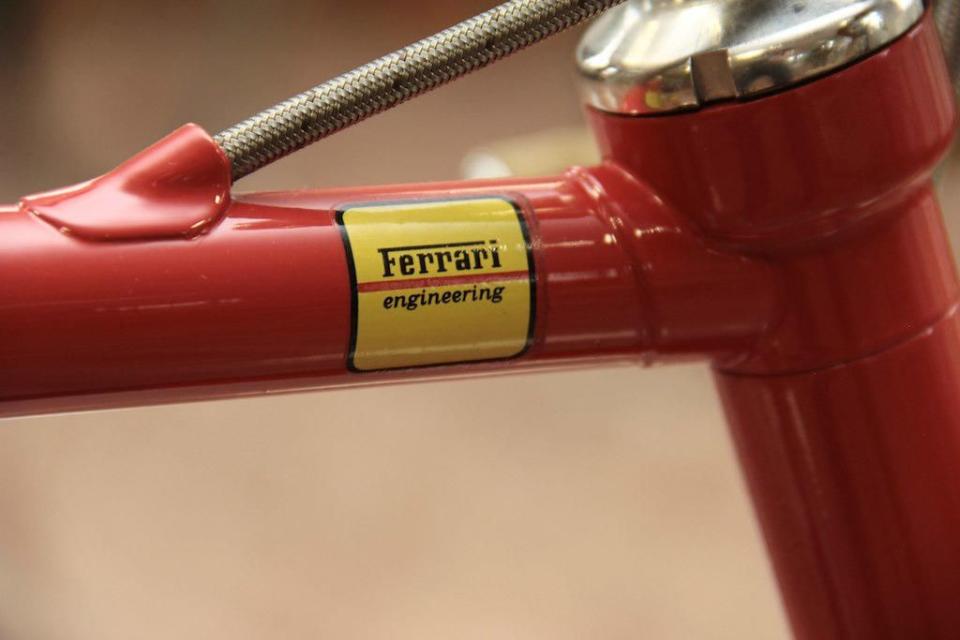
“Carbon is a special material. We began our collaboration with Ferrari because carbon was the progress and I believed they were the best collaborator. From steel to titanium and the next level. The industry evolves. People were skeptical and didn’t trust the bikes would resist the mechanical stress. But it did. We won Paris-Roubaix five times in a row.
“Look. Carbon here. There, carbon, also.”
He takes two pieces of seemingly identically molded carbon fiber and throws one of them to the floor. It makes a high, excruciating sound. Then he throws the other piece and there is a small soft sound as it hits the ground. He looks at me. I nod. What he is saying is this: The first tube is worthless. And I made the second one.
He sits down. He shows his diaries and many of his notes. There are notes everywhere. On the back of envelopes, magazines. Flight tickets. “Look. This is from a Hong Kong trip. I worked on a design on the flight. You see the different drawings. And this is from Mexico, I believe. Yes. I am drawing a new frame here. You see how I change it.”
When he is showing his notes, when he is picking up things, it gives a chilling effect, because everything will someday be on display, arranged by custodians wearing white gloves. But now, it is just notes. He throws them on the desk. We talk more. Small things. He seldom answers a question directly. His mind wanders like Pablo Picasso or Bob Dylan or one of those great artists, because of the manic outlet. It is as if Colnago is a secondary person overseeing the genius that happens to be himself. The way he looks at you. How he looks away. As if he is constantly evaluating his next move and so when you face him, you get the feeling that you are entering his stream of thoughts.
Now he gets on his feet.
“You see. Creativity is born within yourself. You cannot buy it. I have a personal secret: It says: Travel a lot. Sleep little. Fly around the world.”
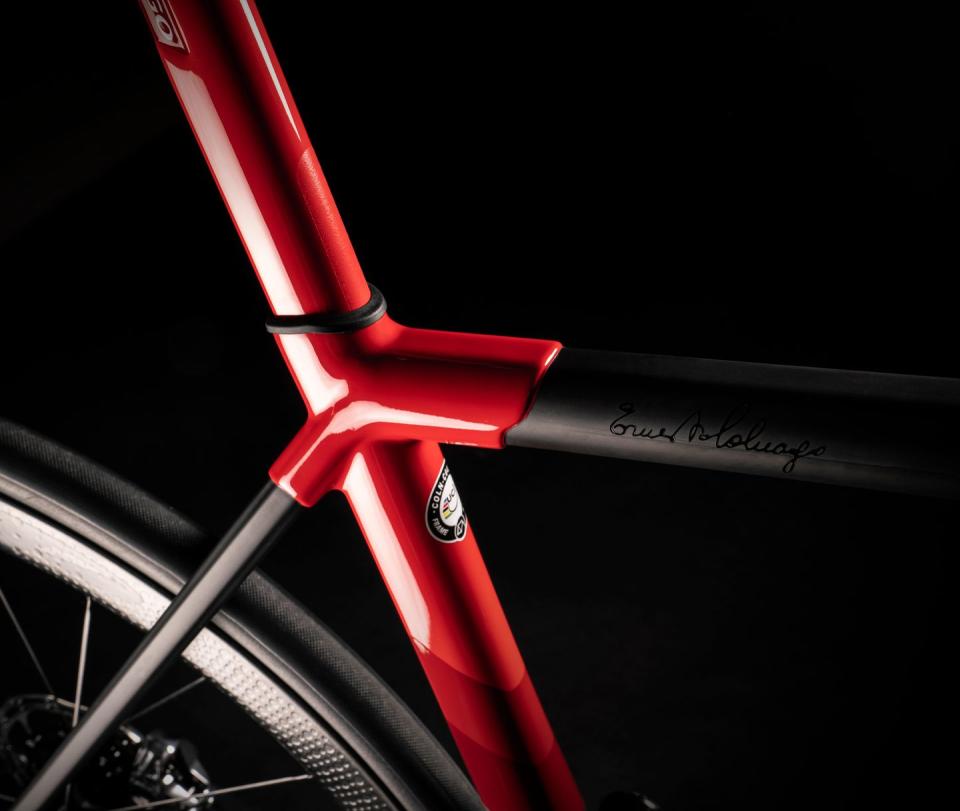
At one point he picks up a book. One of those “1,000 best bikes.” On the cover is a Colnago. Then he picks up a cycling magazine. He is on its cover titled “Legend.” Then he shows me a book. About Colnago. Another book. A picture. Another picture. His winning bikes. On top of the bikes are the most famous cyclists.
From the outside it appears that Mr. Colnago is employed by his own museum to further his legacy. This museum is of course also a functioning factory, and there are people in offices and on the factory floor. But everything in his building somehow belongs in a museum. It has immense historic value for professional cycling. The gear. The man.
At the showroom a couple of hours later, they are all there. The bikes. He either got them personally from the riders or took them at the finish line because he instinctively knew the value of a winning bike. The Colnago press officer, Alessandro Turci, says in low voice, “Mr. Colnago is tireless. And he says this to me, that I must always think about the business. About the bike.”
“Wait. It’s always about the bike? Sean Kelly said something similar.”
“Always about the bike. So Mr. Colnago will say: What’s a good name for a new bike?! How do we develop such and such?! Remember to do this! Do that! And I listen to him and try to learn. It can be a bit stressful here at times, to be around Mr. Colnago. He works constantly. Look. That’s his house right there. Across the road from his own factory. So you can understand the mentality. He says to me: ‘When you are on the toilet, I want you to think about the bikes!’”
Ha!
“Yes! I go, ‘Mr. Colnago, please.’”
Ernesto Colnago is one of cycling’s movable landmarks. He is as known to the fans as the Poggio or Oude Kwaremont. He is our sport’s history and he gets cheered because he has succeeded. While we cheer at Colnago because of what he was, and still is capable of today, we are also cheering because of his age, and no one cherishes the old as the Italians do. That’s right. So this small giant is being cheered just because, and it feels intoxicating to witness. This old man, wherever he goes, people accept him as one of our last masters. Women want to kiss him. And if they dared, but they don’t, men would stick cigars into his breast pocket. In Italy, Ernesto Colnago is considered a national treasure. He has been awarded its great medal, and there are only a handful of acclaimed personalities that the country can bring forward and put on the dining table if they have people coming over. Look. We have one of these!
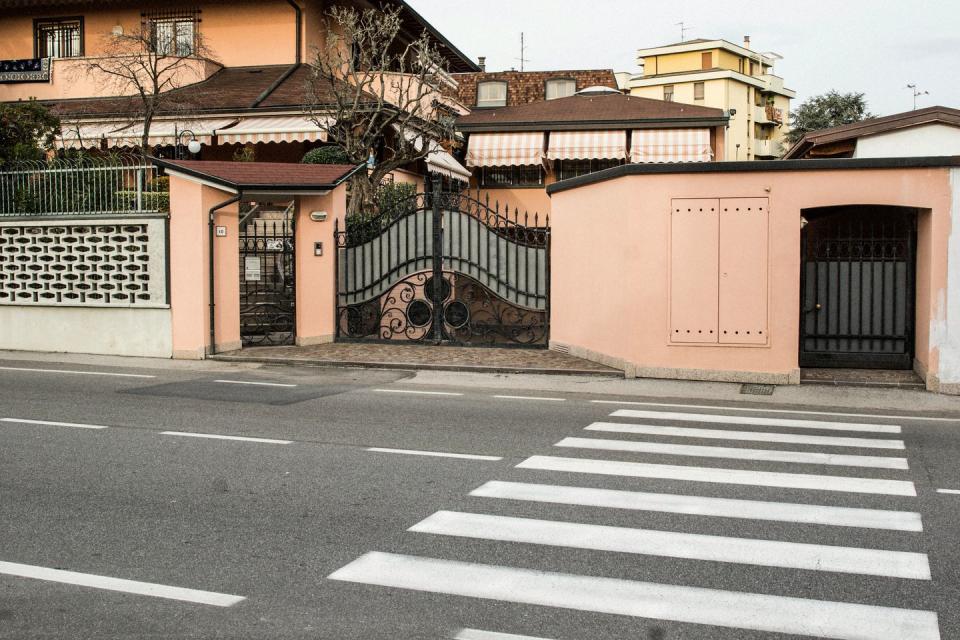
The road that separates the factory from his estate is a small road. There is a pedestrian crossing, a fat dashed line to connect the gate of his home where he thinks about bikes to the gate of his factory where he thinks about bikes. It will take a person approximately four seconds to cross.
Colnago says it’s all about the bike. But it isn’t. Of course it isn’t, I, the mortal writer, speculates. Because Colnago has kids and a wife whose pictures are on his desk. So of course he must think about something else also. But where, where, where does he do it?!
That crossing, that’s the space. The space in time where Mr. Colnago is between his job and his home. I must believe it. It is a space of no-man’s land where he must feel almost trapped each day. Or relieved? That road is arguably the only place on earth where he can obtain a reality of thoughts between bike thoughts-Milk. Do we have milk?-if he has any, which one could doubt. Because the fact that he has narrowed the space between work and leisure into an almost non-space tells us exactly why Mr. Ernesto Colnago has so much to show for, in a lifetime that is literally formidable.
('You Might Also Like',)

